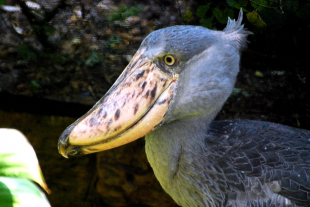Description: Being entirely gray the Shoebill is easily recognized, even without its most distinguishable feature which gives it its name – a bill that resembles a hook-tipped Dutch clog . The head is large in proportion to the body, and the many-colored bill is wide and thick, The hooked bill is 8 – 12 inches (20 – 25 cm) long, 4 – 5 inches (10 – 13 cm) wide and has cutting edges. It has yellow eyes and extremely long toes. Males and females have similar coloration with small crest or white tufts sticking out from the back of the head. The tail is rounded. The tan beak often has dark spots. The legs are skinny and long, like the legs of most wading birds; feet are unwebbed.
Size: The Shoebill stork stands 3.5 – 5 feet (1.07 – 1.5 m) tall; weigh an average of 12.3 pounds (5.6 kg); have an average wingspan of 7.7 feet (2.33 m). Males are slightly larger than females and have longer bills.
Behavior: Shoebills feed mainly by ambush, standing motionless for long periods of time before “collapsing” on the prey in a manner unique for a large fish-eating bird. The “collapse” is unexpectedly swift, generally lasting less than a second and is performed with immense power. The bird flaps forward and plunges its enormous bill down simultaneously. A reinforced beak and skull act as a shock absorber during these violent thrusts. Wings are occasionally held aloft during hunting to assist in balance while the bird walks across unstable matted vegetation. Partially nocturnal, it tends to be sluggish but is also a strong flyer and soarer. Shoebills tend to be solitary, silent birds. Even breeding pairs will feed
at opposite ends of their territory. They have powerful wings which allow them to take off almost vertically. They are somewhat reluctant to fly, but can be seen soaring on thermals over their territory. Food permitting, shoebills are non-migratory. However in some regions, they can be found moving seasonally between feeding and nesting zones. They can be found roosting in trees, but are usually commonly found on the ground near water.
Diet: Shoebills spend the majority of their day fishing. With its head down, using binocular vision, the bird will either stand and wait or walk slowly in the shallow water, often surrounded by grasses and papyrus. Favorite foraging spots include waters low in oxygen, where fish must surface more often. The fish, along with a large amount of water and vegetation, is engulfed in the large bill. The water and vegetation are removed by manipulating the mandible side to side and the fish is decapitated by the sharp edges of the bill. The preferred prey includes lungfish, talipia, birchirs and catfish. They will also eat immature monitor lizards and crocodiles, frogs, water snakes, rodents and even small birds on occasion.
Senses: Vision and hearing are used when foraging.. In order to facilitate binocular vision, shoebill storks hold their heads and bills vertically downward against the breast.
Communication: Shoebills are usually silent, but will participate in the behavior that is characteristic of many storks — “bill-clattering” which seems to be used as a nest greeting. Young shoebills practice this noise as well a “hiccup-like” call for food.
Reproduction: Nesting season begins with the end of the rainy season as the water level starts to drop. Nest are built on true islands or floating vegetation where the water is deep and less likely to dry up as the dry season progresses. After trampling the selected area, plant matter is gathered and woven in, strengthening the nesting area. Shoebills normally lay two eggs (sometimes only one egg and on occasion, three are laid) at intervals of up to five days, with only one egg surviving to fledge. Incubation lasts approximately 30 days and is shared by both parents who turn the eggs and keep them cool by covering with water carried in their enormous bucket-beaks and adding wet weeds on top. Chicks are also cooled by dousing and permitted to drink water from their parents. Upon hatching, chicks are cared for by both parents. Fledging occurs at about 95-105 days.
Habitat/range: They are found in wetlands areas freshwater swamps, dense marshes and areas of papyrus, reed and grass beds in East-Central Africa; southern Sudan (White Nile Sudd), Uganda, Tanzania and Zambia.
Status: Listed as Vulnerable by IUCN; CITES, Appendix II.



